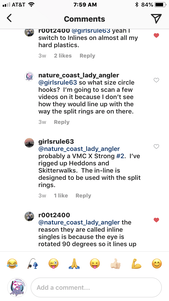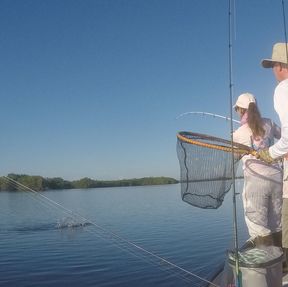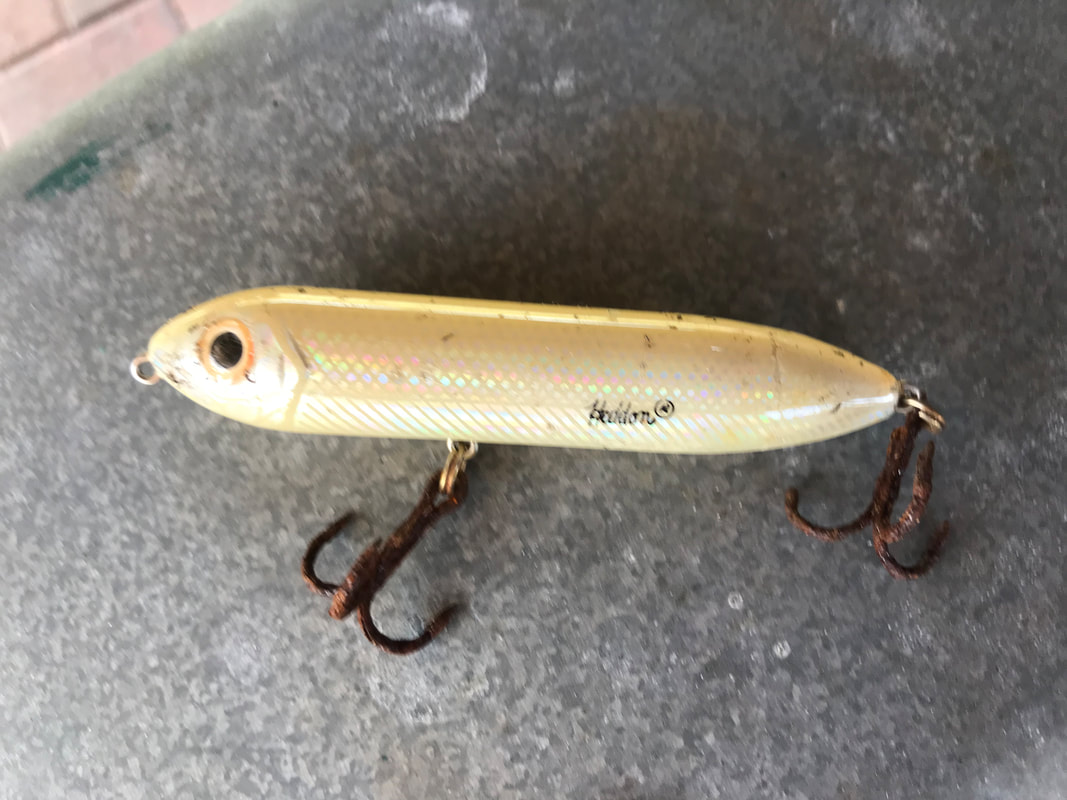
Several weeks ago I drove out to the end of Ozello Trail to visit a good friend who lives just east of the Causeway. We had made plans to do a little fishing together but during our preparations he received a phone call from his son and indicted to me by a quick finger point to his watch that the conversation wouldn't be a short one, so I nodded in acknowledgement and took a stroll around his waterfront property to give him some privacy during the call.
As I slowly ambled along the mangrove lined water's edge, about five minutes into my walk I'd say, something shiny caught my eye. Resting on a patch of grass that the tide had brought in was a bone colored Heddon brand Zara Super Spook Jr., one of my favorite top-water lures. "Bonus!", I thought to myself. Now I've spotted my fair share of entangled and abandoned tackle over the years and because I fish from a kayak, I have the advantage of reaching most mangrove branches in order to salvage many of those lures, bobbers and hooks more easily than the average angler fishing from a motorized vessel. Those folks run the high risk of damaging fiberglass hulls if they take a chance and venture too close to oyster covered shallows that many times run parallel to the mangrove lines. Most of the tackle that I've been lucky enough to recover, however, were not in as good of condition as this particular one was. It looked to me as if it were practically brand new. Let me explain: after this specific lure has been thrown several dozen times, a small section of the coating begins to scratch off because the force of the forward motion of a cast causes the treble hooks to come in contact with the body of the lure and each time those hooks rub up against the lure body (which happens during every cast) a tiny amount of coating gets scratched off. The lure I found had no such damage which led me to believe it was lost by the angler soon after it was tied on. The only down side was that the saltwater had rusted the treble hooks so badly that they would have to be replaced, there was no doubt about that. After a quick evaluation of "my new lure", I was quite pleased at my luck. Trust me when I tell you that I've certainly lost more brand new lures (due to bad line to line knots) than I've found so this fortunate discovery made me a pretty happy girl.

One of the benefits of social media these days is that you can become acquainted with so many other individuals that share the same passion you do that, under normal circumstances, you would never have met. Those platforms are great ways to discuss and share ideas. That's how I learned about the option of changing out treble hooks with circle hooks. Now, we all know that circle/bait hooks are more 'fish-friendly' in that they are designed to be easily removed from a fish's mouth than your typical treble or jig-head style hooks, but it was a new concept to me to switch these hooks right out of the box. Seems that many seasoned anglers have been doing it for years. I had no idea! Since the treble hooks on the lure I happened upon were already rust-damaged and I had to replace them anyway, I thought I'd do a little research and get some practical advise on exactly how to do that. So I hit-up a few fellow Instagram followers and received some great feed-back and encouragement.

Advice was given, suggestions were made and recommendations were offered. The consensus was to purchase 2/0 inline circle hooks and replace the rusty old treble hooks with them. After about an hour of web searching for the correct product, I finally zeroed in on it and ordered a couple of packs. Patiently I waited for them to arrive in the mail. My hands were anxious for a new project.

While "not so" patiently waiting for my hooks to arrive in the mail, I continued to watch several informative YouTube videos on the process and soon came to realize there was a pair of pliers on the market designed specifically for this type of thing. They're called Split Ring Pliers, and had I learned about this tool earlier, I certainly would have ordered a pair when I ordered the hooks, but I was impatient and didn't want to wait yet another week for this item to arrive, which would delay the start of my project. I would have to make due with the two pair of needle-nose pliers that I did have. After all, that's how it was done before split-ring pliers were invented, right?

My husband always beats me home from work and checks the mail before he walks in the door so my daily greeting to him when I finally make it home is, "Hey Babe...did we get any mail?" His response is always, "Sittin' on the counter." And there, sitting on the counter, was a small manila envelope that held those incline circle hooks I had been waiting for. I ripped it open and gave them a curious look. They were quite different than anything I had seen before but I was satisfied with what I had ordered, I set them aside for the time being to get dinner prepared. Here was my plan: Cook dinner, clean up the kitchen and then spend the rest of the evening working on my project while my husband relaxed on the couch and watched "Guy T.V."

Chores were all taken care of for the evening. I took a deep breath, organized my workspace and contemplated how this was all going to work. I knew I could do it, I just had to concentrate and take it one step at a time. Step 1, of course, was to remove the old rusty treble hooks off. That turned out to be a lot easier than I thought. Weeks of rust had compromised the integrity of the hooks and they practically disintegrated under the pressure of the pliers. "That was easy!", I thought.

The next challenge, I knew, would not be so easy. If I gripped the split ring with the needle-nose pliers just right, I could use my mini-screwdriver to wedge an opening small enough to force the eye of the circle hook into the tiny spread. The question was, "How was I going to do that with only two hands?" One hand to grip the pliers, another to hold the screwdriver and that would leave the hook still sitting on the counter. It was a dilemma but one I had to solve. Not only did I have to figure out my process, I also had to make sure that the hooks would be facing in the right direction. Lucky for me, my mother was a very resourceful woman and taught us kids never to give up on something we were trying to accomplish. Focus, figure it out, be persistent! "I can do this!", I said to myself, and after about a 20 minute struggle with my tools, I finally threaded the first hook on and in the right direction too. A sense of accomplishment is a good feeling.

One hook replaced and I felt pretty good about it. I wouldn't consider it easy but I knew I still had another one to put on the back end before I was finished so I took a deep breath and got to it. I had my system down now and the second hook took only half the time. When I completed the final steps I was pretty happy with my accomplishment and my "new" lure. I held it up, gave it a shake or two, listened to that beautiful clickity-clack noise and nodded my head in self-approval, then walked straight to the kitchen calendar to circle a date for the water trial.

Flat, calm water greeted us as my husband and I pulled up to the boat ramp at Ozello Community Park. "This was going to be a good day", I thought to myself. Tide was high and outgoing so we made quick work to get the Gheenoe in the water and on its way. Oyster bars were just beginning to show themselves so I gave my "new to me" redesigned topwater lure a quick kiss for good luck and chunked 'er out there. A few 'twitch-twitch-twitches' and there was a strike and a miss, then another, then another. Whatever it was, it wasn't giving up but I suspected it soon would. Most fish won't hit a hard bait that many times but on the fourth strike he was done and hooked! SWEET - Fish On!! Using these new hooks on a topwater lure wasn't a waste of time after all.

What I brought to the boat, to my complete surprise, was a 20.5 inch bluefish! "Wow", I said, "I haven't caught one of those in years!" I was still in a bit of disbelief that bluefish were hanging around anywhere east of the Ozello Trail causeway, but there it was, up close and personal. As I took a closer look at the hook-set, it was clear that had I given even the slightest bit of slack in my line during retrieval, I probably would have lost it. That hook, as sharp as it was, never fully penetrated through the entire jaw of the fish so I considered myself very lucky to have boated it in the first place. Regardless of the drama, it was my first solid quality fish using the circle hooks on a topwater lure. Success!

After boating "Ms. Blue" and inspecting the precarious hook-set, I was curious about her length. Based on my recollection over the past few years, she looked much bigger than any I had caught before so I was anxious to know. I grabbed my measuring device from the deck of the boat, laid it on a flat surface in the middle of the skiff so I wouldn't lose my fish in case it flopped a little too much and carefully pushed her nose to the -0- mark. She measured a respectable 20.5 inches at the fork of the tail. That was impressive in my book.

Well, I had come full circle. Found a lure, switched out hooks, caught a nice fish, photo-documented the lure that was used, measured the fish and now it was time for a successful release. All of these steps can sometimes keep a quality fish out of water too long which decreases it's survival rate after release. The second most satisfying thing for me, after catching a nice fish, is to release it and watch it swim away strong. That's when you know your C.P.R. (Catch / Photo / Release) was a successful one. This girl took a while longer than I expected to regain her ability to swim off. I held her head deep against the current to get the water flowing through her gills and she finally came around and with a quick thrust of her tail, she let me know she was ready to go. It was a very satisfying feeling to know that a little "lost & found" treasure would bring me something new to learn and do and result in such a rewarding outcome. I'm looking forward to using it again in the near future.
Tight Lines -
Tight Lines -



 RSS Feed
RSS Feed